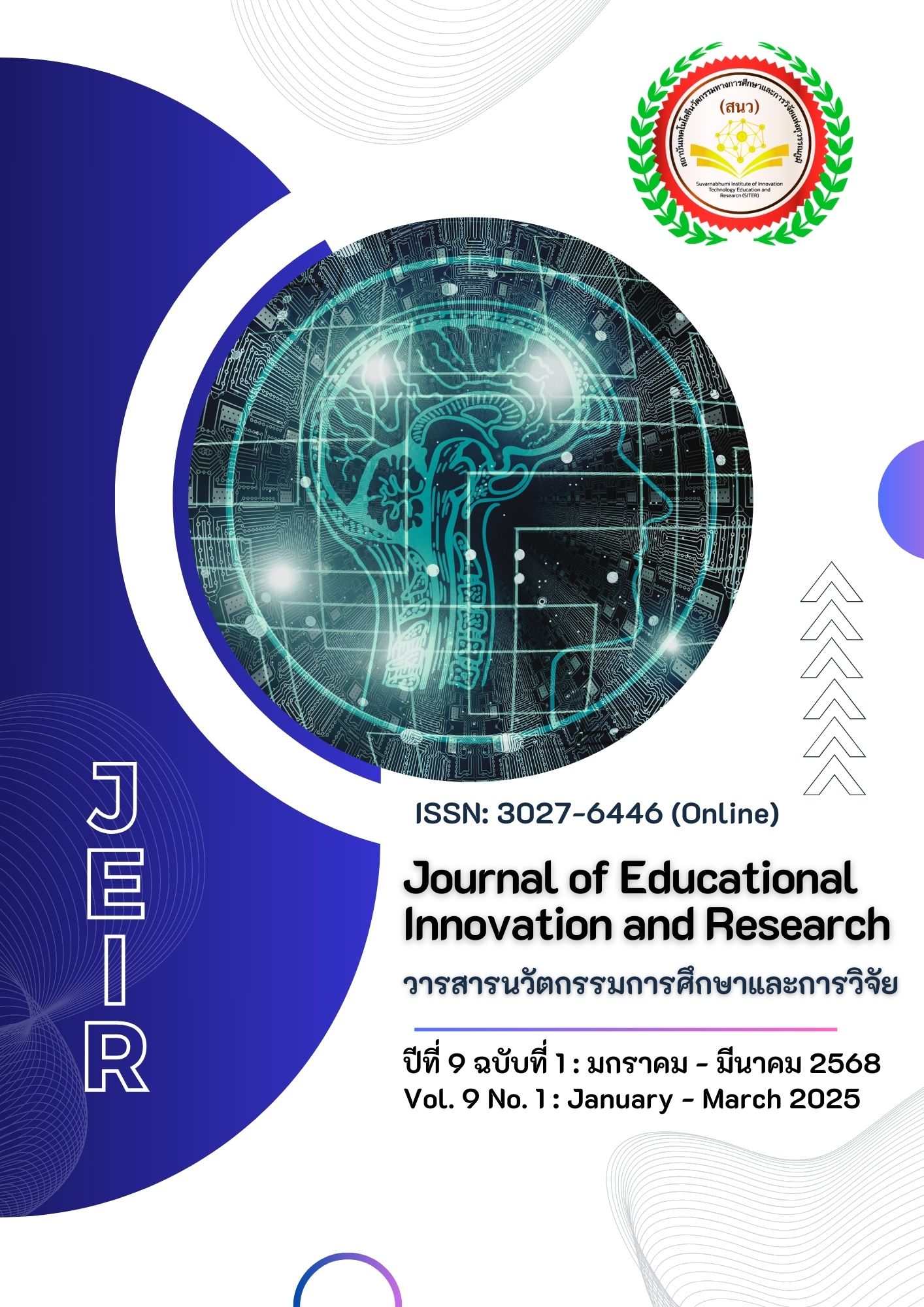รูปแบบการบริหารแรงงานทางด้านการบัญชีของธุรกิจขนาดกลางขนาดย่อม ในกรุงเทพมหานคร
Main Article Content
บทคัดย่อ
บทความนี้มีวัตถุประสงค์เพื่อศึกษาความรู้ที่ได้จากลูกค้า ด้านคุณสมบัติ ด้านความสามารถและด้านนวัตกรรมของแรงงานด้านบัญชีประเภทธุรกิจขนาดกลางขนาดย่อม และศึกษาความรู้ที่ได้จากลูกค้าต่อด้านคุณสมบัติ ความสามารถ และด้านนวัตกรรมของแรงงานด้านบัญชีประเภทธุรกิจขนาดกลางขนาดย่อม เป็นการวิจัยเชิงปริมาณ มีแบบสอบถามเป็นเครื่องมือในการเก็บรวบรวมข้อมูลจากกลุ่มผู้ประกอบการธุรกิจขนาดกลางขนาดย่อมในกรุงเทพมหานคร จากกลุ่มตัวอย่างจำนวน 400 คน ด้วยวิธีการสุ่มตัวอย่างแบบง่าย ทดสอบสมมติฐานด้วยการวิเคราะห์ข้อมูลด้วยค่าร้อยละ ค่าความถี่ ค่าเฉลี่ย ค่าเบี่ยงเบนมาตรฐาน และตัวแบบสมการโครงสร้าง
ผลการศึกษา พบว่า ความรู้ที่ได้จากลูกค้ามีอิทธิพลทางตรงต่อการประยุกต์ใช้ความรู้ให้เกิดประโยชน์ ด้านคุณสมบัติและความสามารถของแรงงานด้านบัญชีมีอิทธิพลทางตรงต่อการประยุกต์ใช้ความรู้ให้เกิดประโยชน์ ส่วนด้านนวัตกรรมมีอิทธิพลทางตรงต่อการประยุกต์ใช้ความรู้ให้เกิดประโยชน์ และการประยุกต์ใช้ความรู้ให้เกิดประโยชน์ มีอิทธิพลทางตรงต่อความสามารถด้านนวัตกรรมของแรงงานด้านบัญชี ส่วนผลการทดสอบสมมติฐาน พบว่า ความรู้ที่ได้จากลูกค้า ไม่มีอิทธิพลต่อการประยุกต์ใช้ความรู้ให้เกิดประโยชน์ โดยมีค่าสัมประสิทธิ์เส้นทาง = .16 และ ค่า t-stat = 1.739 ด้านคุณสมบัติและความสามารถของแรงงานด้านบัญชีมีอิทธิพลต่อการประยุกต์ใช้ความรู้ให้เกิดประโยชน์ โดยมีค่าสัมประสิทธิ์เส้นทาง = .60 และค่า t-stat = 3.489 นวัตกรรม มีอิทธิพลต่อการประยุกต์ใช้ความรู้ให้เกิดประโยชน์ โดยมีค่าสัมประสิทธิ์เส้นทาง = .71 และ ค่า t-stat = 3.489 และการประยุกต์ใช้ความรู้ให้เกิดประโยชน์ มีอิทธิพลต่อความสามารถด้านนวัตกรรมของแรงงานด้านบัญชี โดยมีค่าสัมประสิทธิ์เส้นทาง
= .68 และค่า t-stat = 7.939
Article Details

This work is licensed under a Creative Commons Attribution-NonCommercial-NoDerivatives 4.0 International License.
References
Bank of Thailand. (2020). Annual report of the Bank of Thailand. Accessible from the Bank of Thailand. https://shorturl.asia/fQXUbThailand
Browne, M. W., & Cudeck, R. (1993). Alternative ways of assessing model fit. In K. A. Bollen and J. S.Long (Eds.). Testing structural equation models (pp. 136-162). Sage.
Byrne, B.M. (1994). Structural Equation Modelling with EQS and EQS/Windows: Basic Concepts, Applications, and Programming. Sage.
Cohen, J. (1988). Statistical power analysis (2nd ed.). Erlbaum.
Cronbach, LJ. (1990)Essentials of Psychological Testing. HarperCollins.
Drucker, P. (1985). Innovation and Entrepreneurship: Practices and Principles. Harper & Row, New York.
Goldsmith, R. E., & Foxall, G.R (2003) The measurement of innovativeness. In L.V. Shavinina (Ed.) The international handbook on innovation. kidlington, Oxford Elsevier.
Gurdyoo, T. (2022). The correlation between accounting professional ethics as well as internal control efficiency and the quality of financial report of small and medium enterprise in Bangkok metropolitan areas [Master of accountancy school of accountancy Sripatum University].
JonassenD.H. & Remidez H. (2005). Mapping alternative discourse structures onto computer conferences. International Journal of Knowledge and Learning, 1, 113–129.
Kambil, A., Friesen, G. B., & Sundaram, A. (1999). Co-creation: A new source of value. Utlook Magazine, 3(2), 23-29.
Kline, T. (2005). Psychological testing: A practical approach to design and evaluation. Sage.
Kolb, D.A., et al. (1998). Knowledge adaptation in theory of group process. John Wiley & Sons.
Liao, N. N. H., & Wu, T. C. (2009). The pivotal role of trust in customer loyalty: Empirical research on the system integration market in Taiwan. The Business Revies, Cambridge,12(2), 277-283.
Liao, S. H., Fei, W. C., & Chen, C. C. (2007). Knowledge sharing, absorptive capacity and innovation capability: An empirical study of Taiwan’s knowledge-intensive industries. Journal of Information Science, 33, 340-359.
Liao, S.H., Fei, W.C. & Chen, C.C. (2007).Knowledge sharing, absorptive capacity, and innovation capability : an empirical study of Taiwan's knowledge/intensive industries Journal of Information Science, 33 (3), 56-72.
Matsuo, M. & Kusumi, T. (2002). Salesperson’s procedural knowledge, experience and performance: An empirical study in Japan. European Journal of Marketing, 36 (7/8), 840-854.
Minbaeva, D.B. (2005). HRM practices and MNC knowledge transfer. Personnel Review,34(1),125-144.
Phongpitak, S. (2006). Teaching documents for tax planning. (revised edition). Chiang Mai University.
Quinlan, M. (1998). Labor market restructuring in industrialized societies: An overview. Economic and Labor Relations Review, 9, 1–30.
Ramasamy, S. (2009). Total quality management. Tata McGraw-Hill.
The Accountancy Professional Council under Royal Patronage. (2015). Financial reporting standards. http://www.fap.or.th/index.php?lay=show&ac=article&Id=539873829
Ullman, J. (2014). Ladylike/butch, sporty/dapper: exploring “gender climate” with Australian LGBTQ students using stage–environment fit theory. Sex Educat, 14, 430–443.
Van de Vrande, V., De Jong, J. P., Vanhaverbeke, W., & De Rochemont, M. (2009). Open Innovation in SMEs: Trends, Motives and Management Challenges. Tech-novation, 29, 423-437.
Vanhaverbeke, W. (2006) The Interorganizational Context of Open Innovation. In: Chesbrough, H., Vanhaverbeke, W. and West, J., Eds., Open Innovation: Researching a New Paradigm, Oxford University Press, Oxford.
Vargo, S.L. & Lusch, R.L. (2008). Service-Dominant Logic: Continuing the Evolution. Journal of the Academic Marketing Science, 36, 1-10.
Westland, J. C. (2010). Lower Bounds on Sample Size in Structural Equation Modeling. Published in Electronic Commerce Research and Applications, forthcoming.
Yukl, G., & Lepsinger, R. (2005). Why integrating the leading and managing roles is essential for organizational effectiveness. Organizational Dynamics, 34(4), 361–375.

